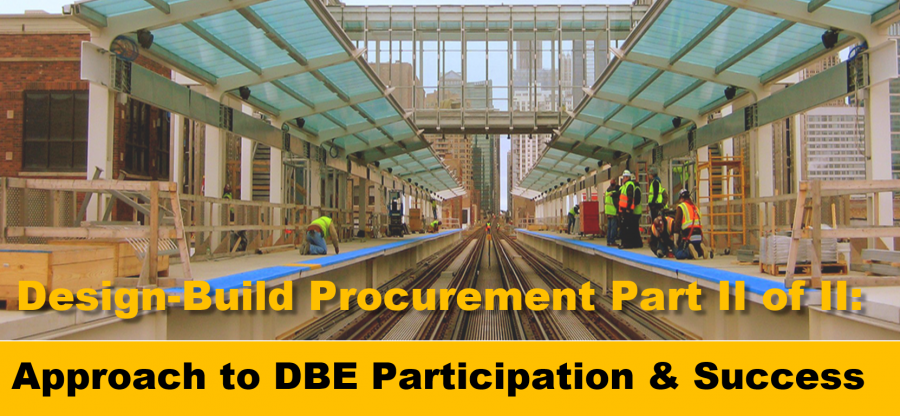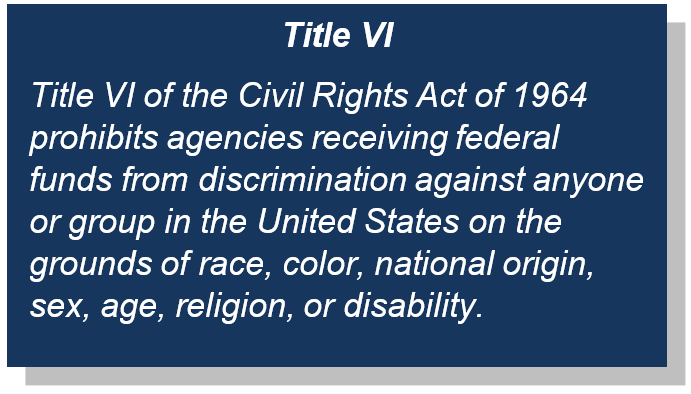Design-Build Procurement Part II of II: Approach to DBE Participation & Success
06/24/2020 | BTG Point of ViewINTRODUCTION
Departments of Transportation (DOTs) have the option of using various project delivery methods, however, there is a movement to increase the use of Design-Build project procurement. To encourage innovation and address financial constraints, DOTs are using a design-build procurement method intended to reduce cost, allow for an accelerated construction period, and increase efficiency. As a result, DOTs have cut hundreds of millions in cost and significant time off construction activity.
See Design-Build Procurement Part I: Approach to DBE Participation & Success here.
Part II
Q: Why are civil rights programs important in the implementation of federally funded Design-Build projects?
A: State and local transportation agencies that receive financial assistance from the United States Department of Transportation are required to establish goals for the participation of Disadvantaged Business Enterprise (DBE) companies. The primary objectives of the Office of Civil Rights (OCR) Program are to monitor Equal Employment Opportunity compliance, labor compliance and contract compliance. Many State Agencies have OCR Program designed to monitor equal contracting opportunities for certified companies on construction projects. Many provide compliance and technical assistance support to certified small businesses, including community outreach, recruit businesses and employees, and disseminate information on contract opportunities.
These offices ensure all management, staff, sub recipients, and services beneficiaries are aware of provisions and mandates of Title VI and the Civil Rights Act of 1964. To ensure the goals of the program are met, the Civil Rights program helps ensure contract compliance while helping small businesses develop sound business practices. Equal Employment Opportunity (EEO), Labor and DBE Compliance checks are required daily for projects utilizing federal funds. These programs are labor intensive to operate and require resources in the field to observe and evaluate construction activity.
Q: What are critical program resource challenges for Design-Build Projects?
A: Due to size, magnitude, and complexity of issues, resource constraints become a considerable problem to support large design-build projects. Many states are preparing for multi-billion-dollar projections, of which, will be their largest in history. Several projects will be combined, different from the traditional approach, and take a much shorter time to complete. Many Agencies are facing the decision of what to do and how to accomplish DBE utilization goals on these large scale and innovative design-build projects with uncertainty regarding capable small business capacity.
A typical Civil Rights program focuses primarily on compliance mandates that are required by the Federal Department of Transportation DBE program. These compliance mandates can be easily addressing if proper dedication and resources are provided for proactive technical assistance. The technical assistance aspects of these programs are more important for large design-build projects because of their size and complexity. A normal road construction project may involve approximately 2 – 3 small businesses with contracts totaling a few hundred thousand dollars, while larger design-build projects will involve hundreds of small businesses with contracts totaling hundreds of millions of dollars. Such magnitude requires available resources (internal or contracted) to support Federal program requirements with credible technical assistance to help address delivery risk issues early. Early intervention is key in helping to prevent adverse impact on a project.
Q: What entities are involved in initial goal setting for small businesses?
A: Partnerships are most successful when there is a true commitment from each business leader, the proper paperwork is completed, and roles and value are clearly delineated. For many Agencies embarking on major Design-Build projects, it will be the first time DBE spending goals will be set for such a unique procurement approach. DOT goal setting organizations should serve as the lead entity. But they should also expect to provide assistance to the prime contractor by establishing an infrastructure which will identify and provide technical support to DBE companies.
Q: What approach should be used to reach the small business goals for Design-Build projects?
 A: Agencies should engage support from a consultant and work together to establish an approach and project plan to manage what will be the largest DBE goal set. This is a traditional project management office (PMO) approach that most organizations take when delivering on a complex, multi-million-dollar project. Establish a team organization, processes, and strategies to increase the likelihood of success. Since these projects are massive construction projects, a goal management structure is also recommended.
A: Agencies should engage support from a consultant and work together to establish an approach and project plan to manage what will be the largest DBE goal set. This is a traditional project management office (PMO) approach that most organizations take when delivering on a complex, multi-million-dollar project. Establish a team organization, processes, and strategies to increase the likelihood of success. Since these projects are massive construction projects, a goal management structure is also recommended.
The goal management structure helps to encourage collaborative planning and functional groups to deal with daily operations and compliance. This team included members of executive management and a functional Work Group. The DBE Steering Committee includes key stakeholders that meet monthly to discuss decisions regarding issues escalated by the Work Group. Roles on the Executive Management Team include Agency executives, the Agency Program Manager, the Agency Chief of Civil Rights, and the prime contractor’s Project Director. An Agency representative is designated as the point of responsibility for the goal and responsible for managing expectations of the corporate and political leaders who were in support of the project.
Q: What is the value-add from developing Scope of Work opportunity sessions?
A: Scope of work (SOW) opportunity sessions are held to provide small businesses with information and contacts for upcoming work opportunities. The key focus of these sessions includes the specific SOW, the bidding processes, and contracting approach. These sessions helped small businesses prepare their technical and business questions prior to the release of the request for proposal (RFP). This approach also allows them to identify ways to add value to the prime contractor by teaming with others or obtaining the equipment they needed to perform the work. After attending these sessions, small business can also network for other potential business opportunities. These sessions offered a win-win for everyone involved and offer the following advantages:
- The prime contractor can lower their risks and then shorten the time needed to identify capable companies; and
- The small businesses can increase their knowledge about specific project work, connecting directly with key people on the prime contractor’s team before the release of the RFP.
These sessions result in millions of dollars’ worth of contracts. The sessions are conducted over the span of project, keeping in step with the contract schedules and deadlines. It is important to note that the SOW sessions are different than outreach sessions. Most of these sessions are conducted in person and structured in concert with time constraints, complexity, and other factors.
After attending the SOW opportunity sessions, small business participants are contacted, independent of the prime contractor, to gauge their intentions to bid and to address any issues preventing their decision to bid. The expected outcome of the sessions are quality bids from small business companies and due process for companies with unsuccessful bids. The process embeds a debrief session with the prime contractors for unsuccessful bidders so they can learn and improve on future bids.
The value of SOW opportunity sessions is demonstrated through a strong commitment to increasing participation goals on hundred-million-dollar design-build projects. Participation in the sessions helps in managing risks to the project schedule, budget, and quality of work, resulting in a true economic impact on the local business community.
Q: What is the benefit of providing construction execution support and continuity for a Design-Build project?
A: After projects are identified and bid opportunities are provided to capable small businesses, a few of them usually need delivery assistance during execution. It is important to dedicate qualified field personnel to routinely visit DBE companies’ work sites during mobilization and throughout execution. This is separate from the inspection services provided by GECs. These visits evaluate and document DBE activities and task that take place in the field and circumstances that present issues for the DBE and the project. DBE field support personnel typically focus on the following concerns:
- Proper site preparation and material deployment
- Safety procedures and personal protective equipment
- Prime contractor’s committed supplies or work conditions
- Methods and means for performance
- Reporting and crew load
Providing this support to companies on a periodic basis, provides perspective of what is happening in the field, and informs comprehensive weekly reports reviewed in the Work Group meetings. These support representatives are not assigned to direct or guide companies but do serve as a confidential conduit, so the communication of project risks come to surface without impacting relationships between the prime and sub-contractors. This process has been proven to be instrumental in improving the successful delivery of services from DBE firms.
In summary, prior to our efforts on many projects, there were questions of whether there were enough qualified companies available to perform on projects of such magnitude. This project approach shows what can be accomplished to answer that question. An increased number of small businesses on large scale-design-build projects are achievable, when properly managed and costs are justifiable.
About BTG: At BTG, we provide turnkey solutions that minimize risk and optimize the inclusion of small businesses on large, complex projects. Headquartered in Washington D.C., our management consulting firm is established as the preferred partner to lead inclusion programs for multi-billion-dollar construction projects and P3 initiatives. We work with public and private sector clients of all sizes to ensure that compliance requirements are met and apply exclusive technology tools and methodologies to cultivate the use of small businesses, so all operate at peak performance. To learn more about BTG, please visit www.btgworks.com.

